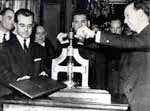The Seal
 The seal is a distinctive mark and sign of authority. In the Middle Ages and under the
Ancien Régime (Old Regime), it was held by a variety of civil or religious authorities, and by the King himself. Today, the seal is reserved for solemn occasions only, such as the
signature of the Constitution and amendments to it. The present-day Seal of the Republic dates from the Second Republic, being struck in 1848.
The seal is a distinctive mark and sign of authority. In the Middle Ages and under the
Ancien Régime (Old Regime), it was held by a variety of civil or religious authorities, and by the King himself. Today, the seal is reserved for solemn occasions only, such as the
signature of the Constitution and amendments to it. The present-day Seal of the Republic dates from the Second Republic, being struck in 1848.
 Under the Old Regime, the Chancellor was a high officer of the Crown,
second in rank after the Connétable (Constable), was a key dignitary. He could not be removed from office, and he did not wear mourning at the death of the King, when the late King's
seal was ritually shattered. Being in charge of the material safeguarding of the dies used to cast the seals, he presided over the sealing of official Acts, a procedure involving a large
number of people.
Under the Old Regime, the Chancellor was a high officer of the Crown,
second in rank after the Connétable (Constable), was a key dignitary. He could not be removed from office, and he did not wear mourning at the death of the King, when the late King's
seal was ritually shattered. Being in charge of the material safeguarding of the dies used to cast the seals, he presided over the sealing of official Acts, a procedure involving a large
number of people.
 In 1718, the
Chancellor moved into a town house in what is now the Place Vendôme, now home to the Minister of Justice and Keeper of the Seals.
In 1718, the
Chancellor moved into a town house in what is now the Place Vendôme, now home to the Minister of Justice and Keeper of the Seals.
At the time of the Revolution, the gold seal of Louis XVI was melted down in order to recover the metal. A decree issued in 1792 for the first time stipulated the design of the new Seal
of the Republic: a woman standing, holding a pike topped by a cap shaped like a beehive, and in the other hand a lictor's fasces.
 Napoleon adopted a seal depicting the typical motifs
of the Empire (bees and the imperial crown).
Napoleon adopted a seal depicting the typical motifs
of the Empire (bees and the imperial crown).
Kings Louis XVIII and Charles X reverted to motifs closer to the old regime, with fleurs-de-lys. Louis-Philippe introduced the tricolor flag alongside the coat of arms of the Orléans family.
 The seal of the Second Republic, still in
use today, was defined by a government decision of September 8, 1848. The medallion engraver Jean-Jacques Barré did not precisely comply with the terms of the decree, particularly with
respect to the placing of the inscriptions, when executing the new Seal of State. A seated woman representing Liberty holds a fasces in her right hand and her left hand rests on a helm
upon which stands a Gallic rooster, its claw resting on top of a globe. An urn bearing the initials "SU" (suffrage universel: universal suffrage) serves as a reminder of the great
innovation of 1848, namely direct universal male suffrage. At the foot of Liberty lie symbols of the fine arts and agriculture.
The seal of the Second Republic, still in
use today, was defined by a government decision of September 8, 1848. The medallion engraver Jean-Jacques Barré did not precisely comply with the terms of the decree, particularly with
respect to the placing of the inscriptions, when executing the new Seal of State. A seated woman representing Liberty holds a fasces in her right hand and her left hand rests on a helm
upon which stands a Gallic rooster, its claw resting on top of a globe. An urn bearing the initials "SU" (suffrage universel: universal suffrage) serves as a reminder of the great
innovation of 1848, namely direct universal male suffrage. At the foot of Liberty lie symbols of the fine arts and agriculture.
The seal bears the inscription "République française démocratique une et indivisible" (Democratic French Republic, One and Indivisible) on the head side, and two mottoes: "Au nom du peuple français" (in the name of the French people) and "Egalité, Fraternité, Liberté" (Equality, Fraternity, Liberty) on the reverse side.
The 1848 decision also defines the type of seals or stamps for regular use by the courts and notaries.
The Third, Fourth and Fifth Republics left the seal unchanged. Under the Fourth Republic, the Constitution alone appears to have borne the seal. Since 1958, the Constitution and certain of the constitutional laws amending it have been given official form with a yellow wax seal hanging from a blue, white and red silk ribbon.
The press from which the seal is stamped is kept in the office of the Minister, who has retained the title of garde des sceaux, or Keeper of the Seals.
|



